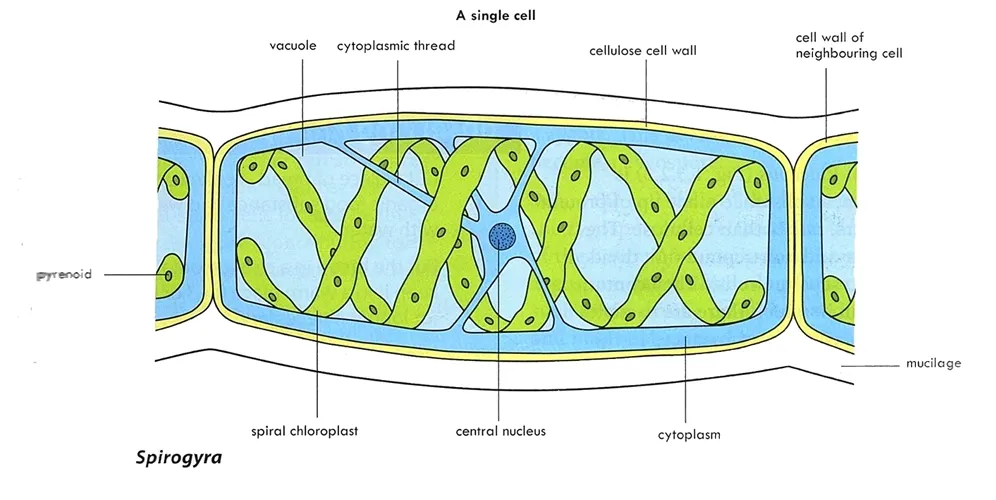Understanding the Structure and Life Processes of Spirogyra: A Detailed Guide
Structure and Life Processes of Spirogyra
Kingdom: Protoctista
Phylum: Chlorophyta
Habitat: Freshwater, ponds, ditches, and slow-moving streams.
Structure of Spirogyra
Spirogyra is a green free floating filamentous alga. It is unbranched with cylindrical cells connected end to end in long filaments.
The cell wall is two layered; the outer wall composed of thick, slimy, protective mucilage while the inner wall is of cellulose.
The cytoplasm forms a thin lining surrounding a large vacuole. It also extends as a thread into the center of the cell to enclose and suspends the nucleus.
The Life Processes of Spirogyra
Spirogyra exhibits a range of life processes that enable it to survive and thrive in aquatic environments.
Nutrition in Spirogyra
Photosynthetic autotroph: makes its own food using energy from sunlight. The chloroplast contains chlorophyll which absorbs energy from sunlight for synthesizing glucose. Excess glucose is converted to insoluble starch and stored in the pyrenoids. This process sustains the alga and contributes to the oxygen supply in aquatic environments.
- Learn more about Photosynthesis in Algae on Britannica.
Respiration
Growth
Osmoregulation
Response to Environmental Conditions
- Read about Algal Blooms and Their Impact on the EPA website.
Reproduction in Spirogyra
Asexual Reproduction: occurs in two forms; binary fission and fragmentation.
Binary Fission: This occurs frequently when conditions are favourable. The nucleus constricts and divides into two. A new cellulose cell wall develops transversely to separate the two nuclei and other cell structures. The two cells do not separate but grow to normal size increasing the length of the filament.
Vegetative Reproduction (Fragmentation): is another form of asexual reproduction. The filament breaks into small lengths. Each fragment becomes a new filament by cell division and cell elongation.
Sexual Reproduction (Conjugation)
- Explore more about Conjugation in Spirogyra on PubMed Central.
Adaptation
¨ Presence of ribbon like chloroplasts for synthesis of glucose.
¨ Pyrenoids for starch storage.
¨ Filament has root-like structures for adhering to substratum.
¨ Each cell wall is surrounded by protective mucilage which prevents desiccation.
Conclusion
Spirogyra is a fascinating filamentous green alga with a unique cellular structure and diverse life processes. Its spiral chloroplasts, ability to perform photosynthesis, and reproductive strategies enable it to thrive in freshwater environments. Understanding the structure and life processes of Spirogyra provides valuable insights into the adaptability and ecological significance of algae in aquatic ecosystems.
For further reading, visit Photosynthesis in Algae on Britannica and Conjugation in Spirogyra on PubMed Central.



